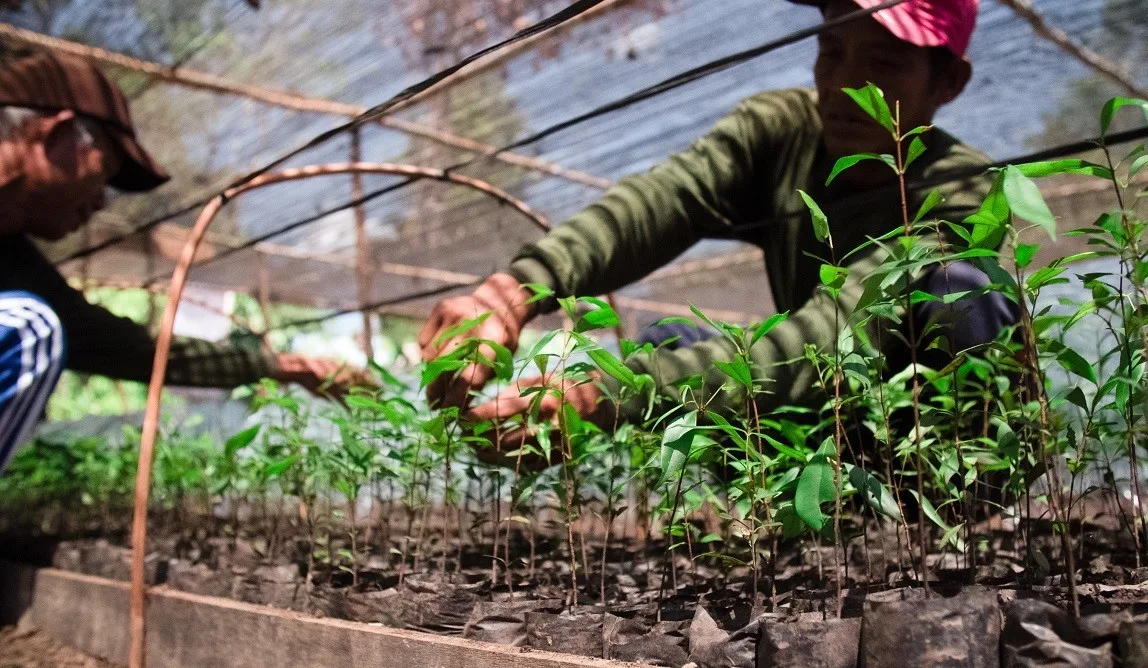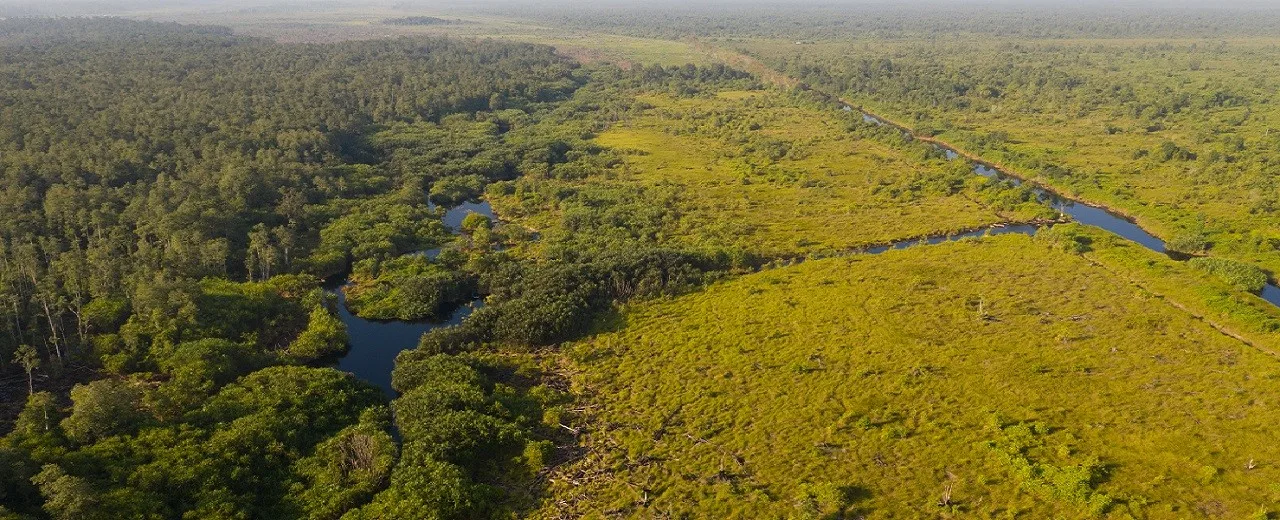 New habitat for Borneo's flora and fauna
New habitat for Borneo's flora and fauna
Revitalising nature: Natural regeneration for CO2 sinks and biodiversity
Imagine there's a fire in Madrid and you're breathing in the smoke in Düsseldorf. Sounds crazy, but that's what happened in the Borneo fires in 2015 and 2019: The smoke cloud travelled 1,500 km to Singapore. Such fires started in drained peat bogs in Borneo, e.g. in Central Kalimantan, where 1,000,000 hectares of rice were to be cultivated in the 1990s. This is also the location of the Mawas, the area where this good deed is being implemented. In 2019, locals here battled fires that raged on the drained mawas. The state fire services were so overwhelmed due to the extreme forest fires in the country that remote areas received little support. But local communities were prepared and were able to bring the fires under control themselves, saving the planted afforestation areas in Mawas. For this, 35 more wells were drilled and hydrants were built to get firefighting water everywhere quickly.
Necessity
Renaturation of degraded peatland rainforest to improve local biodiversity and prevent fires
Activity
The local partner BOS Foundation uses the technique of assisted natural regeneration to renaturalise degraded peatland
Countable effort
In Mawas, 120 - 150 hectares of degraded peat swamp rainforest are being restored
Result
Degraded peat bogs are naturally renatured, CO2 is bound and flora and fauna are provided with a safe home and food
Systemic effect
The risk of forest fires and CO₂ emissions decrease while biodiversity grows in the new peatland rainforest
Background
In the 1990s, the Indonesian government planned a mega rice project in Kalimantan. For this, kilometre-long drainage canals were built to drain one million hectares of peatland and grow rice here (Suyanto et al, 2009). The project failed – but the peat bog was destroyed. Dry peat bog is a fire hazard. It is highly flammable and burns in the depth of the soil. So fires can hardly be extinguished, especially in the dry season. In addition, the CO₂ content of peat bog is up to ten times higher than that of normal soils. Peatland fires are therefore very damaging to the climate. The catastrophic fires of 2015 destroyed 2.6 million hectares of forest in Indonesia and released 1.75 billion tonnes of carbon dioxide equivalent – almost three times the regular annual emissions of all of Indonesia. Thus, in 2015, the country ranked fifth among global CO₂ emitters (Buttler, 2015). The main reason was forest fires, especially peat bog fires. Intact peat bogs in Indonesia are covered by rainforest and thus protected. Clearing and draining peatlands for agricultural purposes destroys the natural balance. And peat bogs that have burned once are very likely to burn again (FAO, 2022). Those who suffer are people, flora and fauna. In addition to financial losses for the local population, the long-term damage to human and animal health is immense. In orangutans, for example, a reduction in fatty tissue and high levels of stress hormones were observed during the fires. As fires affect long-term food availability, they can also have an impact on species survival in subsequent years (Erb et al., 2018).To avoid forest fires in the future, there is a solution: the renaturation of peatlands.
The good deed
The good deed renaturalises 15 m² of peat bog on Borneo, creates a home for wildlife such as orangutans and reduces forest fire risk and CO₂ emissions. The project is located in the 309,000-hectare Mawas, which consists of approximately 55% rainforest and 42% destroyed peat bog. Since 2016, 102 canals have been blocked here and 3,841 hectares of peat bog have been wetted. Trees have regrown on the area of the good deed, which have become wild saplings from the adjacent forest. A new technique is being used to renaturalise the area: Assisted Natural Regeneration, which promotes the natural regeneration of the forest. In the process, the trees are tended and cleared of weeds. In addition, 10,000 seedlings of tree species that benefit wildlife are planted. Since fires could endanger the project despite blocked canals, 20 hydrants will be built for water availability. Because of the fire risk, the area is monitored in the field and with drones.

About Indonesia
Jakarta
Capital
275,501,339
Number of inhabitants
4,788.0
Gross domestic product per capita per year
0,705
Human Development Index
About 2,550 wild orangutans live in Mawas, which also gives the area its name. Because "Mawas" means nothing other than "orangutan" in the language of the indigenous population - the Dayaks.
About the organization and further information
Association
BOS Deutschland e.V.
Website
Further information and source
- Buttler, R. 2015. „Carbon Emissions from Indonesia’s Peat Fires Exceed Emissions from Entire U.S. Economy“. Mongabay Environmental News. 15. Oktober 2015
- Erb, WM., Barrow, EJ., Hofner, AN., Utami-Atmoko, SS., Vogel, ER. 2018. Wildfire smoke impacts activity and energetics of wild Bornean orangutans. Scientific Reports, 8:7606
- FAO. 2022. Peatlands and Climate Planning: Part 1: Peatlands and Climate Commitments. Rome, Italy: FAO
- Koplitz, S. et al 2016 Environ. Res. Lett. 11 094023, “Public health impacts of the severe haze in Equatorial Asia in September–October 2015: demonstration of a new framework for informing fire management strategies to reduce downwind smoke exposure”




